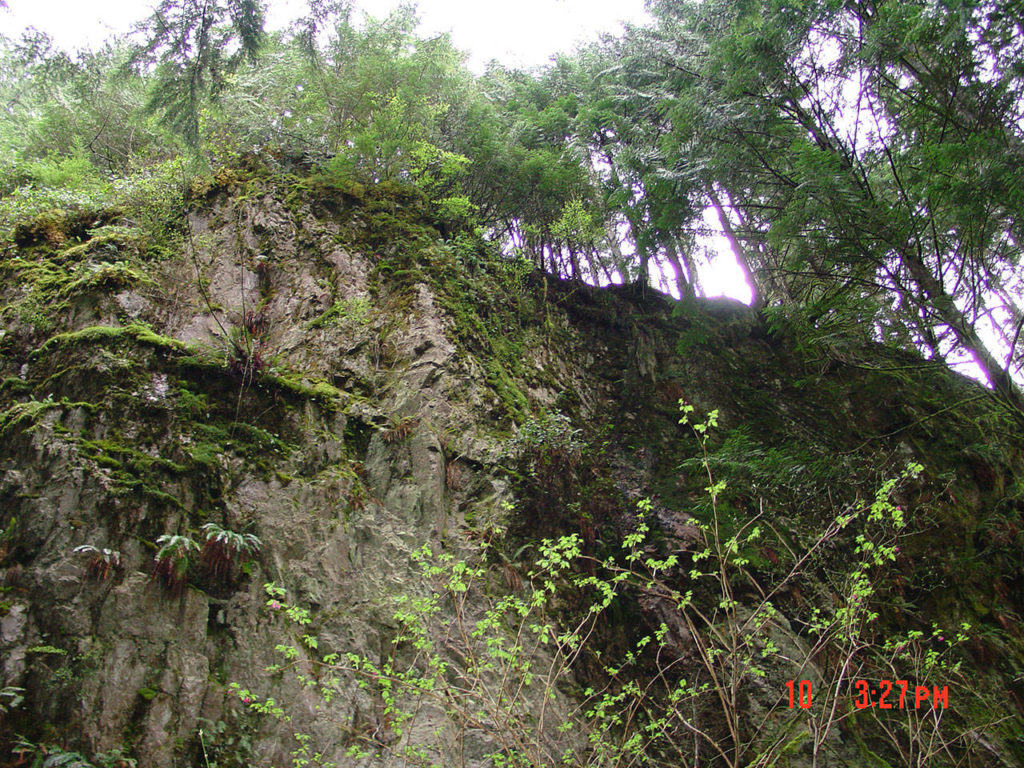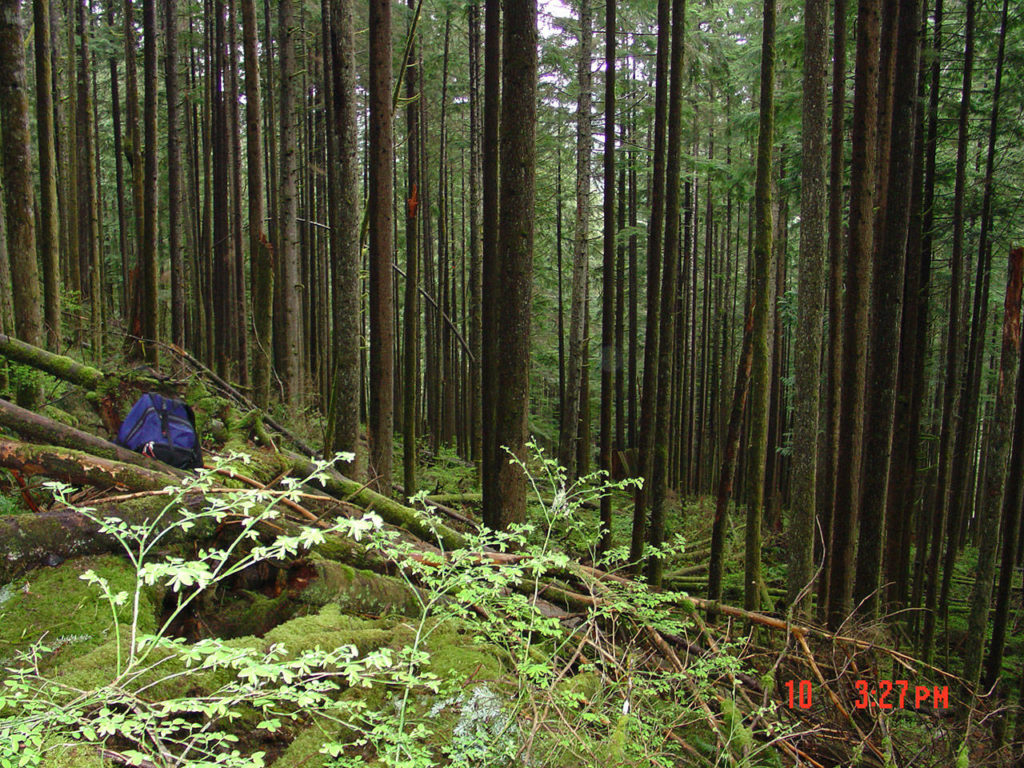SULTAN — About 9½ miles up Sultan Basin Road, the creek runs parallel to the asphalt, a stone’s throw away.
One blustery day in early April 2007, two surveyors pulled over here to explore the woods south of Olney Creek for a logging job they hoped to bid on. On the way back, they blazed a shortcut through the overgrown woods.
Maybe 400 yards from the road, below a rocky cliff covered in ferns and moss, they came upon a simple shelter: a tarp draped from a rope tied to two trees. A few steps east, they saw a jawbone. One tooth had a silver filling. They reported the discovery to the sheriff’s office precinct in Sultan.
Snohomish County detectives found the rest of the skull, more scattered human bones, clothing and the barest of essentials for camping at the site.
The man had been dead a while. Maybe a year. Maybe five. His identity is still unknown. So is what killed him.
This month marks 14 years since the John Doe’s remains were found northeast of Sultan. Investigators believe they are finally close to figuring out the man’s name, with the help of DNA, genealogy research and a fresh drawing of how his face might have looked.
DNA-based family trees created by an Oregon genealogist suggest the Sultan Basin John Doe has deep roots in Texas and Louisiana on one side of his family. On the other side, he has genetic ties to Plain people — as in Amish and Mennonite communities — in Ohio and Indiana. And certainly he has relatives elsewhere.
To restore the man’s identity, detectives need one more solid lead. Anyone who might know his name can contact the Snohomish County Sheriff’s Office at 425-388-3393.
Mystery camp
Time scattered the man’s remains south of Olney Creek.
His cranium sat north of the tent, about 60 feet west of the cliff, a steep slope that turns into a sheer face of rock. A state forensic anthropologist, Dr. Kathy Taylor, found that the John Doe had suffered a head injury “perimortem,” at or near the time of death.
It’s possible a tree or branch fell on him.
It’s possible someone hit him.
The anthropologist’s best estimate put him at age 20 to 50.
Small bones and pieces of bones were perched on a nearby tree stump. A forensic dental exam later suggested he had a crossbite on one side of his smile, at his canines. The lone filling was in a molar. Aside from that, it didn’t seem he had needed much dental work in his life. His teeth didn’t match the charts of anybody missing across the country, when compared to available dental X-rays at the FBI’s National Crime Information Center.
Clothing strewn about the campsite gave few clues about the man’s life story or where he came from. Two Air Jordan tennis shoes. Two black-and-gray “flex” gloves, the kind you might use for gardening. One gray sock. An off-white T-shirt. He evidently brought layers to keep warm: a blue fleece vest, a bluish Timberland beanie and a green jacket.
Containers at the scene could have carried water. A plastic Coca Cola bottle, a Gatorade bottle, a blue antifreeze jug.
Olney Creek is one of the purest streams in the region, according to a recent Snohomish County survey. Cutthroat trout jump in it. Big salmonfly larvae signify healthy water. Surveyors have found Pacific giant salamanders breeding in pools and cobblestones. It may sound remote and wild, but the camp is not far from a paved road. Cars pass often, and detectives wonder if the man would sometimes hitchhike.
As for survival gear, police found only the basics. A Stanley boxcutter. A silver-and-red flashlight. A yellow lighter. A sleeping bag: dark blue outside, light blue inside.
Southwest of the tent — near the shirt, jacket and vest — was a dark backpack. The luxuries were few. One blue plastic razor. One hair brush. That’s about it.
Some things were notably absent.
There was no trace of food. Rodents, birds and insects will pick clean anything edible. But he left no aluminum cans, no wrappers, no shopping bags or other trash debris — at least nothing in the original detectives’ diagram of the camp. There was no visible fire pit. Among the clothes, there wasn’t a single pair of pants. His leg bones were missing, too, including both femurs.
For a decade, that’s what investigators had to work with.
New life
Forensic artist Natalie Murry rebuilt the Sultan Basin John Doe’s face for the first time in 2016, gluing rubber pegs to his bone to estimate the thickness of his skin. She drew him in gray, black and white, with a boxy jaw, a crooked nose and few features that really stick out at first blush.
“I feel like I really didn’t do him justice,” Murry said this month.
Since then, the retired Kent police officer said she has reviewed new academic studies on how to extrapolate a person’s upper lip in life, based on a skull. Murry has also refined her technique in reanimating eyebrows and eyelids, based on other studies that have come out since 2016.
This year, she wanted another shot at the Sultan Basin man. Russian researchers, Murry said, have a theory about the mastoid process, at the base of the skull, and how its angle suggests whether somebody’s earlobes hang free. Something was odd about this man’s ears. The lobe on one side looked to be attached, while the other did not. That’s the kind of tiny thing that can jog a family member’s memory and solve the case. She also revised his nose.
“He’s got that crooked nose,” she said. “One side of his nasal openings is so much lower than the left. … It’s not that I’m drawing it crooked.”
The new drawing bears some resemblance in the general shape of the first man’s face, but he’s a different man.
Drawings can never be a picture-perfect depiction of a face. The hope is a friend or family member will see something familiar in the drawing and call the sheriff’s office.
Haircuts, eye color and skin tone are typically a guess in facial reconstructions, when Murry works with a skull in advanced stages of decomposition. But in the time between these two drawings, new DNA analysis confirmed the man had European heritage; eyes that were most likely green, light brown or hazel; and skin prone to sunburn and freckles.
By 2009, a lab had extracted a mitochondrial DNA profile from the back of the man’s skull, to be compared to missing people in the national database known as CODIS.
Another profile of nuclear DNA was extracted in 2011.
Neither profile produced a match to a missing person.
Forensic DNA techniques have advanced at lightning speed in the past decade or so, helping to crack cases locally and across the nation. After a series of unsuccessful efforts to get a sample for whole genome sequencing in 2017 and 2018, the Snohomish County Medical Examiner’s Office sent the Sultan Basin man’s jaw and hip bone to a private lab, DNA Solutions. Experts there were able to recover 2.6 billionths of a gram of genetic material. That profile was uploaded to GEDmatch, a public database where people can look for distant cousins and other relatives.
GEDmatch has been in the news often, because police and genealogists have also used the database to crack cold case homicides and return names to unidentified bodies. The site’s operators faced public scrutiny in the past for allowing police to dive into publicly shared genetic data by default, virtually unchecked. These days users must tick a box to “opt-in,” for law enforcement to use their DNA to solve crimes.
Since late 2019, genealogist Deb Stone has been trying to track down the man’s family through GEDmatch and other more conventional ancestry research, with the ultimate hope of deducing his identity.
So far she has found the Sultan Basin man has many ties in the Midwest, Texas and Louisiana, as well as some in the Pacific Northwest. If, say, a second-cousin or closer relative were to upload a new DNA profile into the GEDmatch database, the case could be solved today.
So if you have been missing a loved one, you can contact the Snohomish County Medical Examiner’s Office at 425-438-6200. Cold case investigators there can arrange for DNA testing.
Caleb Hutton: 425-339-3454; chutton@heraldnet.com. Twitter: @snocaleb.
Talk to us
> Give us your news tips.
> Send us a letter to the editor.
> More Herald contact information.




























